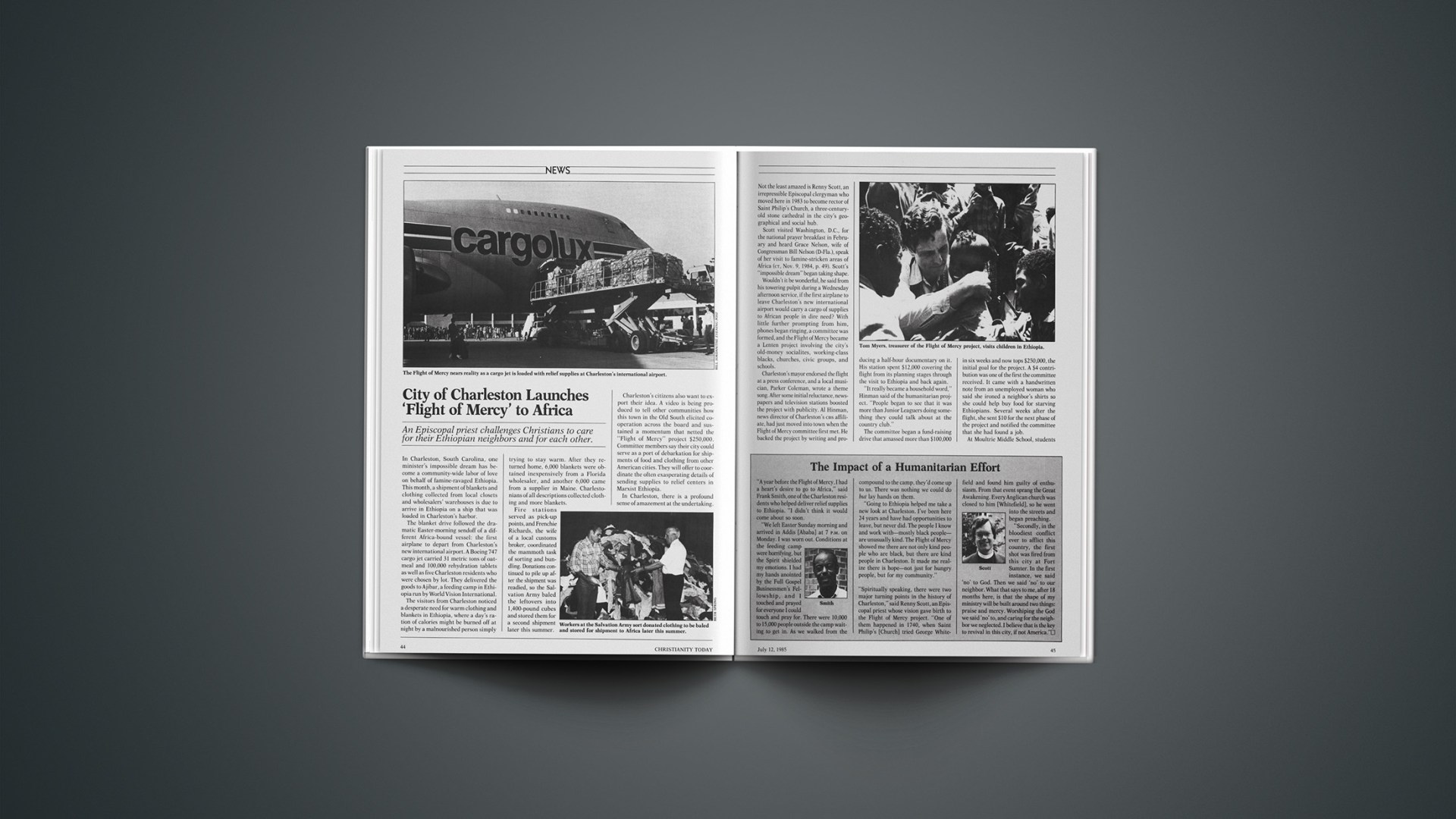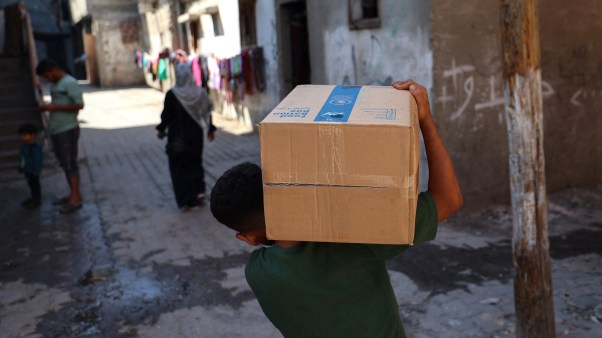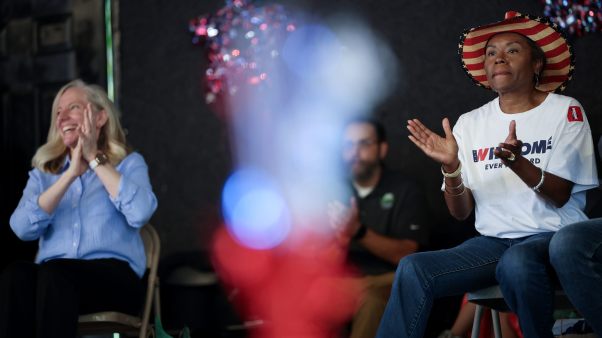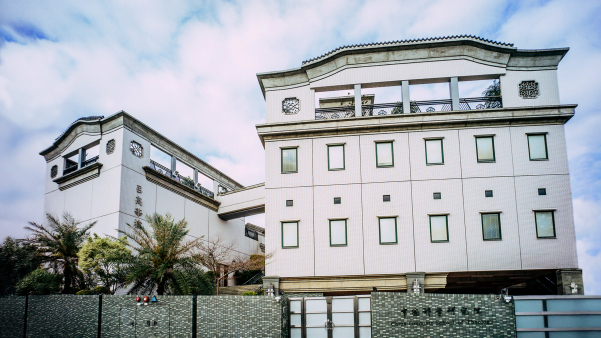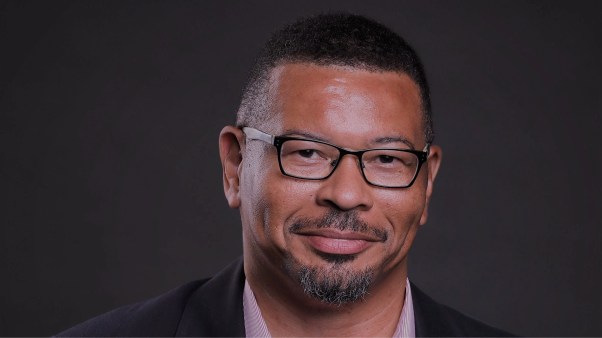An Episcopal priest challenges Christians to care for their Ethiopian neighbors and for each other.
In Charleston, South Carolina, one minister’s impossible dream has become a community-wide labor of love on behalf of famine-ravaged Ethiopia. This month, a shipment of blankets and clothing collected from local closets and wholesalers’ warehouses is due to arrive in Ethiopia on a ship that was loaded in Charleston’s harbor.
The blanket drive followed the dramatic Easter-morning sendoff of a different Africa-bound vessel: the first airplane to depart from Charleston’s new international airport. A Boeing 747 cargo jet carried 31 metric tons of oatmeal and 100,000 rehydration tablets as well as five Charleston residents who were chosen by lot. They delivered the goods to Ajibar, a feeding camp in Ethiopia run by World Vision International.
The visitors from Charleston noticed a desperate need for warm clothing and blankets in Ethiopia, where a day’s ration of calories might be burned off at night by a malnourished person simply trying to stay warm. After they returned home, 6,000 blankets were obtained inexpensively from a Florida wholesaler, and another 6,000 came from a supplier in Maine. Charlestonians of all descriptions collected clothing and more blankets.
Fire stations served as pick-up points, and Frenchie Richards, the wife of a local customs broker, coordinated the mammoth task of sorting and bundling. Donations continued to pile up after the shipment was readied, so the Salvation Army baled the leftovers into 1,400-pound cubes and stored them for a second shipment later this summer.
Charleston’s citizens also want to export their idea. A video is being produced to tell other communities how this town in the Old South elicited cooperation across the board and sustained a momentum that netted the “Flight of Mercy” project $250,000. Committee members say their city could serve as a port of debarkation for shipments of food and clothing from other American cities. They will offer to coordinate the often exasperating details of sending supplies to relief centers in Marxist Ethiopia.
In Charleston, there is a profound sense of amazement at the undertaking. Not the least amazed is Renny Scott, an irrepressible Episcopal clergyman who moved here in 1983 to become rector of Saint Philip’s Church, a three-century-old stone cathedral in the city’s geographical and social hub.
Scott visited Washington, D.C., for the national prayer breakfast in February and heard Grace Nelson, wife of Congressman Bill Nelson (D-Fla.), speak of her visit to famine-stricken areas of Africa (CT, Nov. 9, 1984, p. 49). Scott’s “impossible dream” began taking shape.
Wouldn’t it be wonderful, he said from his towering pulpit during a Wednesday afternoon service, if the first airplane to leave Charleston’s new international airport would carry a cargo of supplies to African people in dire need? With little further prompting from him, phones began ringing, a committee was formed, and the Flight of Mercy became a Lenten project involving the city’s old-money socialites, working-class blacks, churches, civic groups, and schools.
Charleston’s mayor endorsed the flight at a press conference, and a local musician, Parker Coleman, wrote a theme song. After some initial reluctance, newspapers and television stations boosted the project with publicity. Al Hinman, news director of Charleston’s CBS affiliate, had just moved into town when the Flight of Mercy committee first met. He backed the project by writing and producing a half-hour documentary on it. His station spent $12,000 covering the flight from its planning stages through the visit to Ethiopia and back again.
The Impact of a Humanitarian Effort
“A year before the Flight of Mercy, I had a heart’s desire to go to Africa,” said Frank Smith, one of the Charleston residents who helped deliver relief supplies to Ethiopia. “I didn’t think it would come about so soon.
“We left Easter Sunday morning and arrived in Addis [Ababa] at 7 p.m. on Monday. I was worn out. Conditions at the feeding camp were horrifying, but the Spirit shielded my emotions. I had my hands anointed by the Full Gospel Businessmen’s Fellowship, and I touched and prayed for everyone I could touch and pray for. There were 10,000 to 15,000 people outside the camp waiting to get in. As we walked from the compound to the camp, they’d come up to us. There was nothing we could do but lay hands on them.
“Going to Ethiopia helped me take a new look at Charleston. I’ve been here 24 years and have had opportunities to leave, but never did. The people I know and work with—mostly black people—are unusually kind. The Flight of Mercy showed me there are not only kind people who are black, but there are kind people in Charleston. It made me realize there is hope—not just for hungry people, but for my community.”
“Spiritually speaking, there were two major turning points in the history of Charleston,” said Renny Scott, an Episcopal priest whose vision gave birth to the Flight of Mercy project. “One of them happened in 1740, when Saint Philip’s [Church] tried George Whitefield and found him guilty of enthusiasm. From that event sprang the Great Awakening. Every Anglican church was closed to him [Whitefield], so he went into the streets and began preaching.
“Secondly, in the bloodiest conflict ever to afflict this country, the first shot was fired from this city at Fort Sumter. In the first instance, we said ‘no’ to God. Then we said ‘no’ to our neighbor. What that says to me, after 18 months here, is that the shape of my ministry will be built around two things: praise and mercy. Worshiping the God we said ‘no’ to, and caring for the neighbor we neglected. I believe that is the key to revival in this city, if not America.”
“It really became a household word,” Hinman said of the humanitarian project. “People began to see that it was more than Junior Leaguers doing something they could talk about at the country club.”
The committee began a fund-raising drive that amassed more than $100,000 in six weeks and now tops $250,000, the initial goal for the project. A $4 contribution was one of the first the committee received. It came with a handwritten note from an unemployed woman who said she ironed a neighbor’s shirts so she could help buy food for starving Ethiopians. Several weeks after the flight, she sent $10 for the next phase of the project and notified the committee that she had found a job.
At Moultrie Middle School, students amassed $2,100 selling doughnuts. Assistant principal Jeff Erickson said the sale was launched by the school’s sixth-grade teachers. “The kids felt compassion for Ethiopia, and they recognized their own affluence. They were excited about the group effort,” Erickson said. “Once that feeling permeated the school, there was no stopping it.”
Carey Bownds, a third grader at Pepperhill Elementary School, said his bus driver leads the children in singing “We Are the World,” a rock song that has generated money for famine relief.
The Flight of Mercy airlift cost far more than sending supplies by ship, but representatives of World Vision who coordinated the project said the long-range benefit of energizing an entire community weighed heavily in their decision to go ahead with the flight. The flight cost $132,000, while sending a boatload of supplies costs about $45,000.
Paul Samuels, a regional representative for World Vision in Charlotte, North Carolina, said the airlift “fulfilled a growing awareness that we see across the country for people not just to give their money, but for a city to become intimately involved with a project or a village. Now Charleston so identifies with Ajibar that the two have become one in their hearts.”
Criticism leveled at the Flight of Mercy came from people who wondered why resources should be spent abroad rather than at home. “That represents two basic misunderstandings,” Scott told critics. “First, there is nothing comparable in the United States to what is happening in Ethiopia today. Secondly, we are doing an enormous amount in this city now with soup kitchens and shelters. It’s not an either-or option.”
From his pulpit, Scott has captivated a congregation that has doubled in size since he came to Charleston in 1983. To boost the Flight of Mercy, he described his own “mental fantasy of being a dad in Ethiopia and not being able to provide for my wife and children.” Afterward, a parishioner told him, “I’m glad you preach that way because I’ve never thought of them as people before.”
Scott’s impossible dream is a first step, he said, toward sensitizing Christians about poverty and about caring for their neighbor. “I think the long-term implications of it have not yet been realized.”

